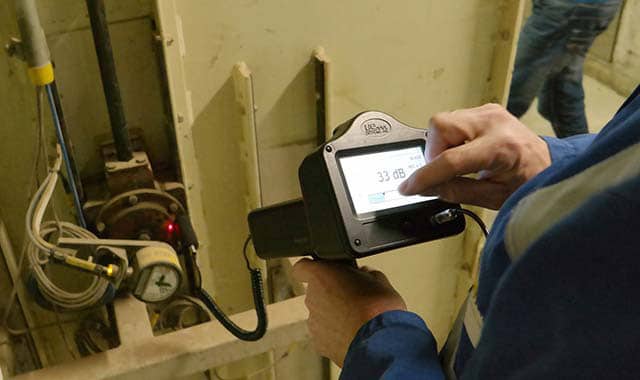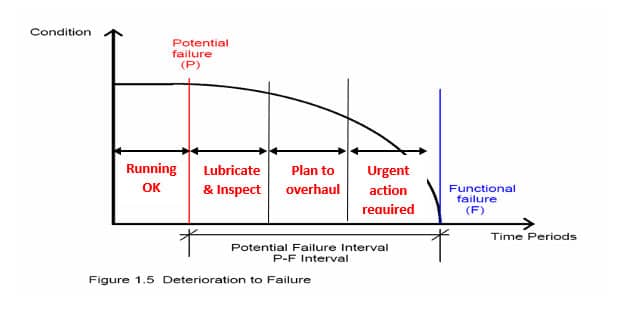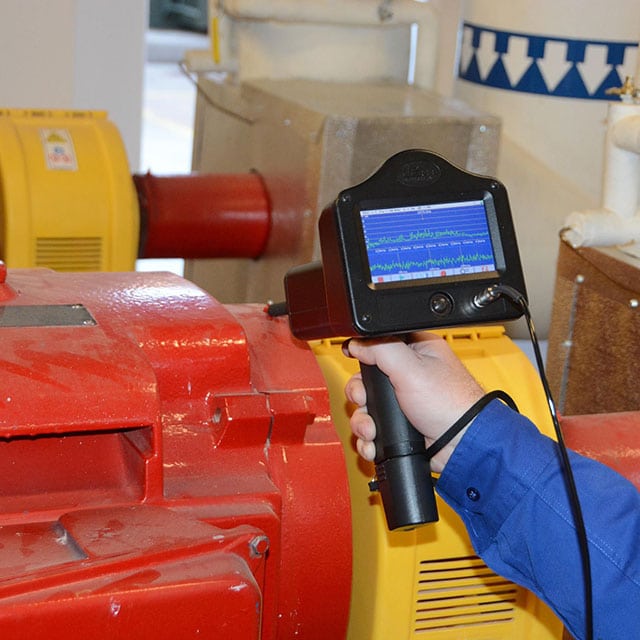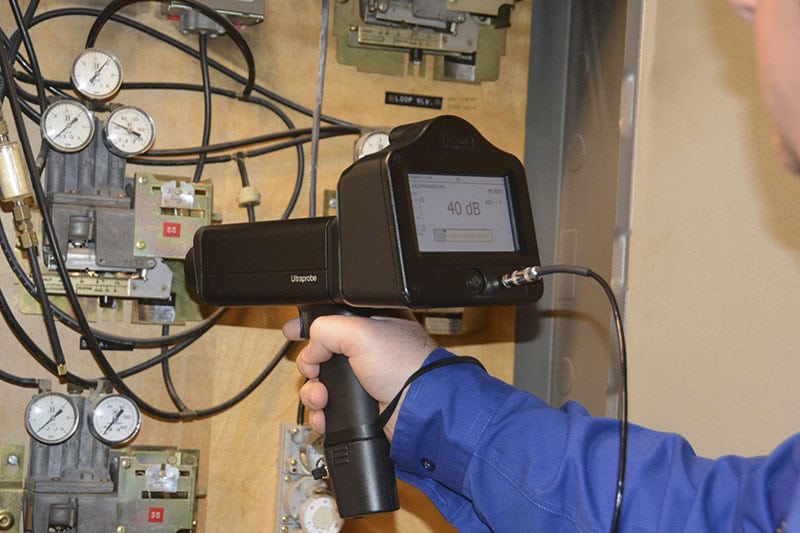Services | Condition Based Monitoring
Ultrasound Inspections
Ultrasound
Our Engineers are fully trained in Ultrasound monitoring and hold the UE Systems Ultrasound qualifications.
DMS use the Ultrasound equipment in conjunction with our vibration monitoring equipment to monitor closely rotating equipment. In order to detect incipient bearing failure, then ultrasonic is one of the most reliable tools available. Ultrasonic warnings appear prior to rise in temperature or an increase in low frequency vibration levels. Ultrasonic inspection of bearings is useful in recognising:
- a) The beginning of fatigue failure.
- b) Brinelling of bearing surfaces.
- c) Flooding of or lack of lubricant.
In ball bearings, as the metal in the raceway, roller or ball bearing begins to fatigue a subtle deformation begins to occur. This deforming of the metal will produce an increase in the emission of ultrasonic sound waves.

Heterodyned Signal
The ultrasonic frequencies detected by an Ultrasonic inspection device are reproduced as audible sounds. This “heterodyned” signal can greatly assist a user in determining bearing problems. A good bearing is heard as a rushing or hissing noise. Crackling or rough sounds indicate a bearing failure stage. In certain cases’ a damaged ball can be heard as a clicking sound whereas a high intensity rough sound may indicate a damaged race or uniform ball damage. A loud rushing sound that is rougher than a good bearing indicates a symptom of lack of lubricant (See the P-F curve example).
Changes in amplitude of from 12 to 50 times original amplitude reading is an indication of incipient bearing failure. When a reading exceeds any previous reading by 12dB, it can be assumed that the bearing has entered the beginning of the failure mode.
High volume bearing inspections like at a bakery would use a comparative inspection method. This is where a good bearing is located and then used as a comparison to determine a poor or bad bearing. Because of such high numbers of inspection points, historical data collection would add to time spent on site, which instead is utilised in testing more amounts of bearings. Vibration analysis is used instead as a form of historical data collecting.

Benefits of Ultrasonic Inspections
Overview of benefits of Ultrasonic Inspections
- Bearings up to 2 metres from auditing engineer can be checked
- Each bearing takes an average of <10 seconds to check
- Fault indications are very accurate
- A high volume of inspections can be carried out in a day
- Slow speed applications are monitored with same equipment
- Ultrasonic detection will improve any lubrication strategy
- Additional influencing noises can be audible whilst inspecting, such as electrical, mechanical looseness can be reported on
- Quick analysis can be used to aid current machine or plant status
We recommend a compressed air leak survey at regular intervals or if your plant energy costs are starting to rise without explanation.
In addition to the financial costs, significant air leaks can also cause a drop in system pressure and therefore efficiency of your plant.
Using our ultrasound equipment, our Engineers are able to determine the amount of leaking compressed air in cubic feet/minute.
We then take your energy costs per kWh to calculate the value of electricity being wasted each year.
Ultrasonic Inspection Characteristics
Using the characteristics of Ultrasound, locating leaks is fast and easy to do:
- Directionality of sound waves makes locating the source easy
- Intensity of signal: the closer you get, the more sound you detect
- Fixed frequency, making it effective to locate even in a loud factory environment!
- As any gas (air, oxygen, nitrogen, etc.) passes through a leak orifice, it generates a turbulent flow with detectable high frequency components.
- By scanning the test area with an Ultraprobe, a leak can be heard through the headset as a rushing sound or noted on the display/meter. The closer the instrument is to the leak, the louder the rushing sound and the higher the reading.
- Should ambient noise be a problem, a rubber focusing probe may be used to narrow the instrument’s reception field and to shield it from conflicting ultrasounds.
- In addition, Frequency Tuning (available in most models) dramatically reduces background noise interference to provide ease of ultrasonic leak detection as never before experienced.
Once our survey is complete, measures can be taken to seal any leaks found which can be as simple as replacing a valve, o-ring, seal or pipe joint. We can then return to site and check how much the leaks have improved. Common causes of air leaks can be faulty valves, corrosion on old pipework/hosing or accidental damage to pipe joints or connections.

